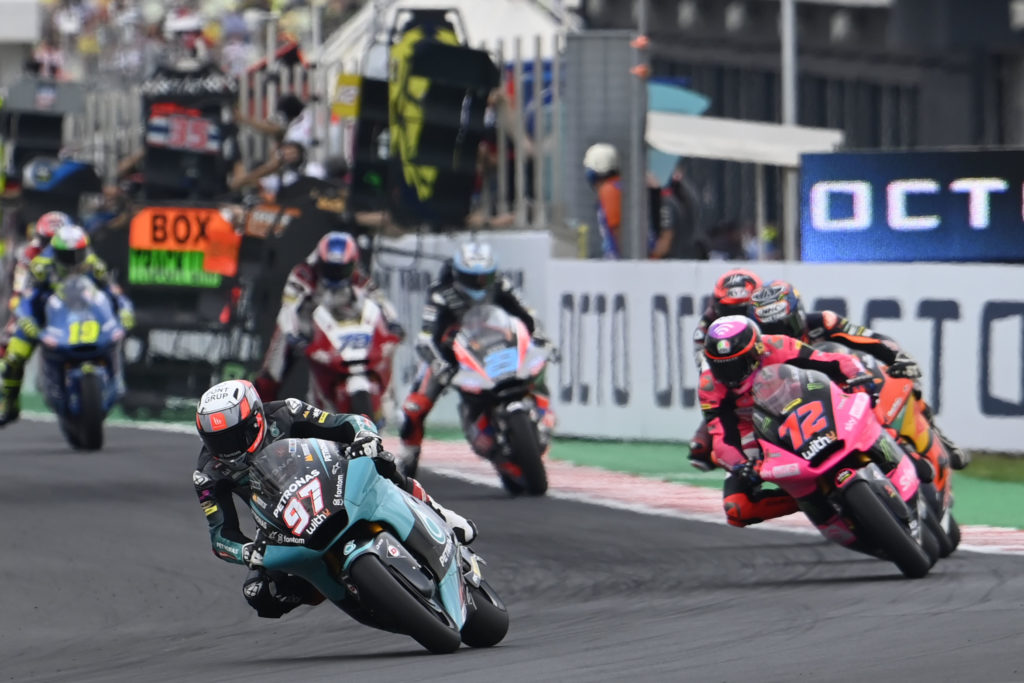How much does a MotoGP bike weigh?
MotoGP and Formula 1 are two of the premier racing sports in the world. While the former is in two-wheeler racing the latter is in a four-wheeler. Both sports are dangerous and the competitors know it. Both vehicles can easily exceed speeds of 350 kilometres per hour. While an F1 car weighs 9 to ten times the weight of the driver, a MotoGP bike weighs twice the weight, or more, of the driver.
A MotoGP bike generates over 250 bhp of power while an F1 engine generates more than 1000 bhp. The weights (of the driver/rider), the speeds of the two vehicles and the power output of the engine look very unbalanced. So, what is the weight of a MotoGP bike and how does it affect racing?
This article will take a look at the weight of a MotoGP bike and the effect the driver’s weight has on it. In formula 1, a car has to weigh a maximum with the driver seated in the car. Contrastingly, a MotoGP bike has to weigh a minimum without a rider mounted on it. While Moto2 and Moto3 insist on a minimum combined weight (bike and the rider), MotoGP insists on weighing the bike without the driver mounted on it.
SEE ALSO: KTM’s Search For Perfection Starts Now…

The reason for weighing only the bike is that riders’ weights might differ by twenty kilograms or more from each other. This difference in weight cannot be adjusted with the weight of the machine. While in Formula 1 the difference would be insignificant and can easily be adjusted with the car, in MotoGP it wouldn’t. If the bike and the engineers had to adjust the weight of the rider with that of the bike, the competition would be very uneven. It would favour the lighter and smaller drivers more than the taller and heavier ones.
What do MotoGP bikes actually weigh?
A MotoGP bike has to weigh a minimum of 157 kilograms (346 pounds). Anything below that and the rider is liable to be summarily disqualified. The FIM has different specifications of weights for different classes of Grand Prix racing. Marco Simoncelli (183cms/72kg) and Valentino Rossi (182cms/ 67kg) were two of the taller and heavier riders. Their weight and height not only slowed down their bikes but also took a heavier toll on their rear tyres. They petitioned the FIM to have a combined minimum weight for MotoGP just like in the lower categories. Dani Pedrosa (160cms/51kg) suggested, rather cheekily, that both of them should “try being smaller.” The petition was rejected.
While Moto2 and Moto3 both have combined minimum weights, MotoGP specifies a minimum weight for the bike only.
- Moto3 (250cc) 152 kg (motorcycle + rider)
- Moto2 (600cc) 215 kg (motorcycle + rider)
- MotoGP (till 800cc) 150 kg (motorcycle only)
- MotoGP (till 1000cc) 157 kg (motorcycle only)
Understandably, diminutive riders have a more difficult time handling a 157kg beast that can speed at 380 plus kilometres per hour. But heavier and taller drivers have their own problems too. That is evident from the fact that most of the drivers that finish in the top ten are diminutive and weigh lesser.
How does the weight of a rider impact MotoGP racing?
In formula 1 racing a driver’s torso is strapped firmly to the seat. MotoGP riders have no such protection. In case of a mishap, a MotoGP rider is just thrown off the bike. A MotoGP rider has to have a firm grip on the handlebars. As a result, the wrists are subject to a lot of strain. A MotoGP rider has to tackle the full force of the wind he is speeding through. He also has to counter the G-forces exerted when braking while cornering. Some of the riders end up with swollen wrists at the end of a race. The only option then is to sit out the next race if the rider does not recover in time.
Taller and bulkier riders offer more resistance to the wind. This results in a drag that takes up part of the power generated by the engine meaning reduced speed. With bulkier and taller riders the centre of gravity is shifted upwards. They are forced to lean the bike to an even greater angle when cornering than lighter riders. Although bikes can lean to 64 degrees, a heavier driver means there is every chance of skidding.
Taller drivers also cannot lean too far forward and into the wind to reduce resistance. This would put their wrists in an awkward position and they are likely to lose control of the bike. Thus the rear wheel of a taller driver bears more load than that of a smaller and leaner driver. The rear wheels wear out faster when a taller driver is riding a bike as more weight is born by the rear wheels. Even though a taller driver may be faster when the race starts, he will slow down considerably as the race progresses. In MotoGP racing, even a fraction of a second, a lap, makes a telling difference.
Conclusion
The weight of all the bikes in MotoGP will be almost the same as that stipulated by the FIM. Given that, the weight and the height of the driver do make a difference. The fact also remains that talent also matters a lot in MotoGP as shown by Valentino Rossi. Rossi has won the most number of Grand Prix despite being rather tall. But the debate on whether only the bike should be weighed, or with the driver, is not yet over.
